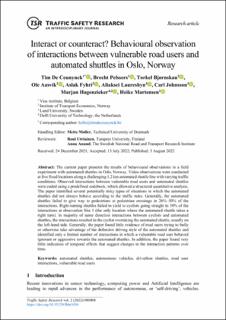| dc.contributor.author | De Ceunynck, Tim | |
| dc.contributor.author | Pelssers, Brecht | |
| dc.contributor.author | Bjørnskau, Torkel | |
| dc.contributor.author | Aasvik, Ole | |
| dc.contributor.author | Fyhri, Aslak | |
| dc.contributor.author | Laureshyn, Aliaksei | |
| dc.contributor.author | Johnsson, Carl | |
| dc.contributor.author | Hagenzieker, Marjan Paula | |
| dc.contributor.author | Martensen, Heike | |
| dc.date.accessioned | 2023-06-15T13:05:04Z | |
| dc.date.available | 2023-06-15T13:05:04Z | |
| dc.date.created | 2022-11-04T15:32:19Z | |
| dc.date.issued | 2022-08-03 | |
| dc.identifier.issn | 2004-3082 | |
| dc.identifier.uri | https://hdl.handle.net/11250/3071586 | |
| dc.description | De Ceunynck, T., Pelssers, B., Bjørnskau, T., Aasvik, O., Fyhri, A., Laureshyn, A., Johnsson, C., Hagenzieker, M., & Martensen, H. (2022). Interact or counteract? Behavioural observation of interactions between vulnerable road users and autonomous shuttles in Oslo, Norway. Traffic Safety Research, 2, 000008. https://doi.org/10.55329/fbhr3456 | en_US |
| dc.description.abstract | The current paper presents the results of behavioural observations in a field experiment with automated shuttles in Oslo, Norway. Video observations were conducted at five fixed locations along a challenging 1.2 km automated shuttle line with varying traffic conditions. Observed interactions between vulnerable road users and automated shuttles were coded using a predefined codebook, which allowed a structured quantitative analysis. The paper identified several potentially risky types of situations in which the automated shuttles did not always behave according to the traffic rules. Generally, the automated shuttles failed to give way to pedestrians at pedestrian crossings in 26%–50% of the interactions. Right-turning shuttles failed to yield to cyclists going straight in 38% of the interactions at observation Site 1 (the only location where the automated shuttle takes a right turn). In majority of same direction interactions between cyclists and automated shuttles, the interactions resulted in the cyclist overtaking the automated shuttle, usually on the left-hand side. Generally, the paper found little evidence of road users trying to bully or otherwise take advantage of the defensive driving style of the automated shuttles and identified only a limited number of interactions in which a vulnerable road user behaved ignorant or aggressive towards the automated shuttles. In addition, the paper found very little indication of temporal effects that suggest changes in the interaction patterns over time. | en_US |
| dc.language.iso | eng | en_US |
| dc.publisher | Lunds universitets [University Publisher], Institutionen för teknik och samhälle [Imprint] | en_US |
| dc.rights | Navngivelse 4.0 Internasjonal | * |
| dc.rights.uri | http://creativecommons.org/licenses/by/4.0/deed.no | * |
| dc.subject | automated shuttles | en_US |
| dc.subject | autonomous vehicles | en_US |
| dc.subject | driverless shuttles | en_US |
| dc.subject | road user interactions | en_US |
| dc.subject | vulnerable road users | en_US |
| dc.title | Interact or counteract? Behavioural observation of interactions between vulnerable road users and autonomous shuttles in Oslo, Norway | en_US |
| dc.title.alternative | Interact or counteract? Behavioural observation of interactions between vulnerable road users and autonomous shuttles in Oslo, Norway | en_US |
| dc.type | Journal article | en_US |
| dc.type | Peer reviewed | en_US |
| dc.rights.holder | © 2022 Tim De Ceunynck, Brecht Pelssers, Torkel Bjørnskau, Ole Aasvik, Aslak Fyhri, Aliaksei Laureshyn, Carl Johnsson, Marjan Hagenzieker, Heike Martensen | en_US |
| dc.source.articlenumber | 000008 | en_US |
| dc.description.version | publishedVersion | en_US |
| cristin.ispublished | true | |
| cristin.fulltext | original | |
| cristin.qualitycode | 1 | |
| dc.identifier.doi | 10.55329/fbhr3456 | |
| dc.identifier.cristin | 2069378 | |
| dc.source.journal | Traffic Safety Research (TSR) | en_US |
| dc.source.volume | 2 | en_US |
| dc.source.pagenumber | 1-24 | en_US |
| dc.relation.project | Norges forskningsråd: 283338 | en_US |

